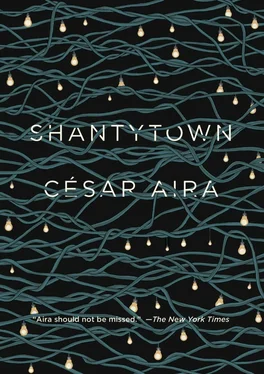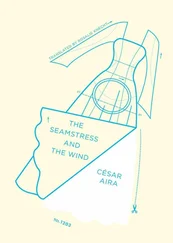“We’re going to have a coffee and calm down,” he said, as if they’d gone out for a spin. The girls were too rigid with fear to react, so he invented a detail to make it more convincing: “You can walk back home from here when it stops raining.”
This sounded plausible, even though the end of the rain seemed a world away. They got out and made a dash for it. The place was empty, except for a pair of sweethearts holding hands and talking in whispers, their gazes oscillating between the windows and the television over the door. The newcomers sat down at a table and stared at the screen. The show was just beginning.
They saw it all. Cabezas was so fascinated by what was happening on the television and by his own thoughts that the girls could have slipped away without him noticing, but oddly enough it seemed that they were in no hurry to be gone. It was still raining just as heavily, and they didn’t want to get wet; in the state they were in, a trivial consideration like that mattered more than being at the mercy of a man described by the reporters as a dangerous criminal. Also, they didn’t want to miss any of the dramatic events unfolding on the screen.
Although Cabezas had been waiting for the judge to pronounce his name, when she did, he couldn’t help whispering, “The bitch!” But what came next was more surprising. It was obvious that they really were getting him mixed up with the father of Cynthia Cabezas; they’d spun a whole plot out of that misinformation. For some time he’d been haunted, as the hunted often are, by the old idea that he was caught up in a case of “mistaken identity.” When he heard the judge’s words and saw the old pictures on the television, the idea took on monstrous proportions: not just huge, but deformed. It wasn’t that they had mixed him up with another man, leaving his true identity aside; they knew who he was and they were still mistaking him for someone else. If he’d been a better sport, he might have admitted that he had it coming because he was the one who’d started the confusion. But he wasn’t in the mood for subtleties like that.
He looked on helplessly as the images followed one another, and the error reinforced itself and spread. He began to wonder how far it could go. Could it go all the way round and come back to bite the tail of the truth it had left behind? The only way to stop it expanding would have been to impose a universal silence. . And the human race wasn’t going to stop talking. There was no point trying to set the record straight. Once a misunderstanding was out there, it couldn’t be reeled back in. The only solution was to make the best of it and press on, improvising all the way. Somehow, things worked out in the end, mysteriously enough. Even so, a feeling of deep despondency had come over him, due in part to the fierce insistence of the rain, both on the television and outside the windows of the pizzeria. The water was still rising. That sea of error: the world. And he had to keep going, on and on, burdened with all the solipsisms of his sloppy thinking and a mass of information drawn exclusively from television, bits and pieces as random as the sequence of episodes in a dream. He had to keep fleeing forward, but to where? What would become of him? Was he destined to be an eternal fugitive, eternally forbidden to look back? His despondency was deepening and coming to seem inflexibly ordained. This line of thought led him to the conclusion that his case was irremediable; after all, only the human could be remedied. .
Meanwhile on the esplanade, where everyone had paused to respect a mother’s pain, the action was resuming. The cameras focused on Judge Plaza again, and she regained her fighting spirit. The manhunt was beginning: the judge and all her officers disappeared into their cars, in one of which they stowed the corpse, and drove off leaving boiling wakes in the big choppy lake that had covered the avenue. The breathless commentaries of the news girls, who were following the police in their various trucks, explained that they were heading for the nearby shantytown, which was still crowned with a great dome of light. According to the television — which is the very essence of action and therefore never wrong — the judge had ordered her samurais to take up positions all around the edge, and as soon as the perimeter was secured, she would go in herself, leading the way, armed to the teeth, ready to kill or die.
An unforgettable spectacle was about to unfold. The broadcast was charged with anticipation: millions of viewers were following the events in real time. The rain had broken all the records and its density and violence were still increasing. The shantytown must have been flooded, but the action was rushing on regardless, without waiting for conditions to return to normal. The apocalyptic downpour was becoming a mere backdrop to the adventure: people were beginning to act as if it were some kind of special effect.
And the rain served as a bridge to convey the sense of adventure because it was raining both on the scene where the events were taking place and on the houses of the people who were following the coverage; the rain was beating on the roofs and the walls, seeping in under the doors. . Cabezas shifted on his seat and noticed that there was water underfoot. The floor of the pizzeria was submerged. The streets outside were a sea: the water was already up to the windows of his car, which was parked in front of the door. Twice a minute, flashes of lightning lit up the view.
Cut to the helicopters, which had reached the shantytown and were circling over it. The view was dizzying because of the height, the movement and the darkness. It had been a feat, as the commentators were quick to point out, to fly there in that weather, defying the rain, the headwinds and the lightning. The blades were spinning in a mass of almost solid water. The uncontrollable lurching resulted in shots of the nightbound city in which the horizon was vertical or sloping, sometimes even upside down. You could also see the other helicopters battling with the elements, and gauge what the storm was doing to them. SUICIDE MISSION TO BRING YOU THE NEWS, said the lettering on the screen, leaving nothing to the imagination.
Nevertheless, the airborne cameras kept aiming downward, and were able to provide vertical views of the shantytown from about seven hundred feet directly above its center. You could see the whole circle traced out in those famous, over-abundant lights, each little bulb a twinkling signal fixed in the rain-drenched darkness.
Quite apart from the unusual circumstances, the spectacle was interesting from an intellectual and aesthetic point of view. No one had ever seen the shantytown like that, in its entirety. It was a ring of light, with clearly marked lines going in at an angle of 45 degrees to the circumference, none of them leading to the center, which was dark, like a void. These “geometrical” shots were brief because of the buffeting, but also because they were interrupted by images from the ground, where, like amphibious creatures, the patrol cars were speeding along, followed by the news trucks, and taking up positions all around the shantytown. Nevertheless, the shots from overhead kept getting clearer. The ring was not evenly bright, but composed of ribbons and twirls: a profusion of tiny figures that, given more time and tranquility, the eye might have been able to decipher.
Suddenly, Cabezas let out a startled cry. He had been visited by a sudden “illumination” and not just metaphorically. A complete and convincing solution to the enigma that had resisted him for years was swimming into view. It was all thanks to the aerial shots, the “electrical map” — and, of course, the corresponding synapses in his brain. The broadcast that he was watching had also played its modest part: the style of the news channels, superposing images and text, favored or rather maximized redundancy. Once the picture was complete, it all seemed so clear, so utterly self-evident. When you tuned into that frequency, titles began to appear over your own mental images, and that was enough to throw a powerful light on the old mysteries. In this case, the caption that lit up in Cabezas’s brain said: THE PATTERNS OF LIGHTS ARE USED TO IDENTIFY THE STREETS OF THE SHANTYTOWN. Those quirky garlands of bulbs — no two the same — at the entrance to each oblique street were “names” in a code that the dealers had been using, quite openly, to guide their clients. The system was foolproof: they used names that were easy to remember (like “the square,” “the triangle,” “the parallel lines,” or “the hair”), changed the location every night, or several times a night, and waited until the buyers were already circling the shantytown before calling them on their cell phones to tell them where to go.
Читать дальше












